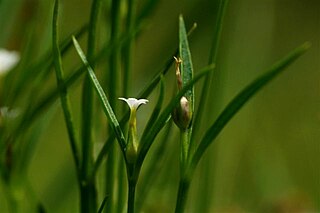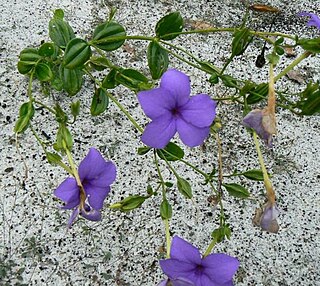
Gentianales is an order of flowering plant, included within the asterid clade of eudicots. It comprises more than 20,000 species in about 1,200 genera in 5 families. More than 80% of the species in this order belong to the family Rubiaceae.

Opisthocomidae is a family of birds, the only named family within the order Opisthocomiformes. The only living representative is the hoatzin which lives in the Amazon and the Orinoco delta in South America. Several fossil species have been identified, including one from Africa and one from Europe.

Coccoloba is a genus of about 120–150 species of flowering plants in the family Polygonaceae, which is native to the Neotropics. There is no overall English name for the genus, although many of the individual species have widely used common names.

Alstroemeriaceae is a family of flowering plants, with 254 known species in four genera, almost entirely native to the Americas, from Central America to southern South America. One species of Luzuriaga occurs in New Zealand, and the genus Drymophila is endemic to south-eastern Australia.

Gentianaceae is a family of flowering plants of 103 genera and about 1600 species.

Centaurium (centaury) is a genus of 20 species in the gentian family (Gentianaceae), tribe Chironieae, subtribe Chironiinae. The genus was named after the centaur Chiron, famed in Greek mythology for his skill in medicinal herbs. It is distributed across Europe and Asia.

The genus Macrocarpaea, with 105 species and two hybrids of 0.5 m herbs, shrubs, epiphytes and small trees to 10 m tall, is the largest genus of the tribe Helieae of the gentian family (Gentianaceae). Species of Macrocarpaea have diurnal and nocturnal pollinators, visited during the day by hummingbirds, insects and butterflies, and at night by bats, moths and many different kinds of insects. The common name for the genus is 'Moon-gentian'. No species are known in cultivation.
Gondwanatitan was a titanosaurian sauropod dinosaur. Gondwanatitan was found in Brazil, at the time part of the southern supercontinent Gondwana, in the late Cretaceous Period. Like some other sauropods, Gondwanatitan was tall and ate tough shoots and leaves off of the tops of trees. G. faustoi's closest relative was Aeolosaurus.

Attalea is a large genus of palms native to Mexico, the Caribbean, Central and South America. This pinnately-leaved, non-spiny genus includes both small palms lacking an aboveground stem and large trees. The genus has a complicated taxonomic history, and has often been split into four or five genera based on differences in the male flowers. Since the genera can only be distinguished on the basis of their male flowers, the existence of intermediate flower types and the existence of hybrids between different genera has been used as an argument for keeping them all in the same genus. This has been supported by recent molecular phylogenies.

Schenkia sebaeoides, known as ʻĀwiwi in Hawaiian and lavaslope centaury in English, is a rare species of flowering plant. It is endemic to low shrublands in the state of Hawaiʻi in the United States. It is present on the islands of Kauai, Oahu, Lanai, Molokai, and Maui. At the time it was added to the endangered species list of the United States in 1991 it was known from seven populations for a total of fewer than 1000 individuals. It is threatened by habitat loss.

Zeltnera muehlenbergii is a species of annual herb commonly known as Monterey centaury and Muhlenberg's centaury. It is native to western North America from British Columbia to California and Nevada, where it commonly grows in forests and other moist places. This is an annual herb growing thin, erect, branching stems to heights anywhere between 10 centimeters and one meter. Oval-shaped leaves are arranged oppositely on the stem and are up to 2 or 3 centimeters long. The branching inflorescence bears many flowers, each with small bracts at its base. The flower has five oval-shaped petallike lobes each a few millimeters long.

Schenkia spicata is a species of annual herb in the family Gentianaceae. It has a very wide old world distribution, ranging from north Africa, through Europe and into Asia.

Cerro de la Neblina, also known as Serra da Neblina in Brazil and Sierra de la Neblina in Venezuela, is a sandstone massif located in the northern Amazon Basin. It is a tilted, heavily eroded plateau, with a deep canyon in its central portion, drained by the Baria River.

Sebaea is a genus of annual plants in the family Gentianaceae. Species occur in Africa, Madagascar, India, China, Thailand, Australia and New Zealand. The genus was paraphyletic and has been split in four genera: Exochaenium, Klackenbergia, Lagenias and Sebaeas.str.. Synapomorphies for Sebaea s.str. include the presence of extra stigma along the style and the shape of the testa cells of the seeds.

The genus Exochaenium is endemic to sub-Saharan Africa, with species occurring in most tropical and sub-tropical regions of the continent, particularly on the Katanga plateau, with many extending to the Sudano-Zambesian and Guineo-Congolian regions. The genus is monophyletic and is used to study the variation and evolution of herkogamy.

Klackenbergia is a genus of flowering plants belonging to the gentian family (Gentianaceae) and the tribe Exaceae. It only contains two species, both endemic to Madagascar. They are notable for their inflorescence with characteristic long bracts and bracteoles and sub-sessile flowers arranged in axillary fascicules at each node.

Exaceae is a flowering plant tribe in the family Gentianaceae. Exaceae comprises about 180 species assigned to eight monophyletic genera, with major centres of endemism in continental Africa, Madagascar and the southern tip of India and Sri Lanka (14 endemic species).

Tachiadenus is a plant genus in the gentian family (Gentianaceae), tribe Exaceae. It contains 12 species. The genus is endemic to Madagascar.
Ornichia is a plant genus in the gentian family (Gentianaceae), tribe Exaceae. The genus is endemic to Madagascar.
Gyrandra is a genus of flowering plants in the family Gentianaceae, found in Texas, Mexico and Central America. Annual herbs, they are usually found in montane pine-oak forests.















